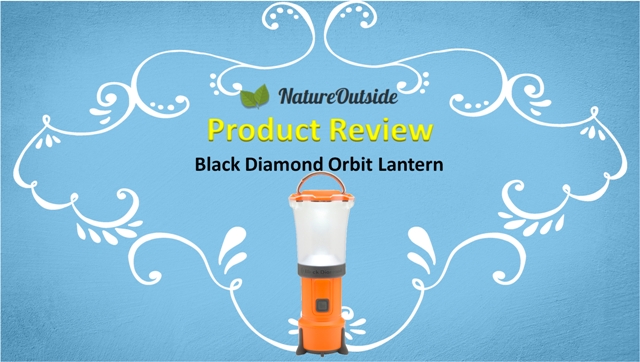
It is a wonderful time to be a hiker, camper, or backpacker!
As technology rushes forward our wilderness gear advances with it. Gone are the onerous external frame packs, the burdensome tents, and the itchy wool clothing. Today’s outdoor gear is lighter, smaller, and often more reliable. That’s what I call progress!
LED Lanterns
It is better to light a candle than curse the darkness.
– Proverb
Gone also is the clunky white-gas lantern. Popularized by Coleman, these lanterns were the mainstay of campers everywhere. How many discussions under the stars were accompanied by the hiss of a Coleman lantern?
Romance aside, I won’t miss the broken mantles and worrying about how much gas remained in the tank. I remember saying a little prayer to the “Lantern God” each time I lit one.
Efficient and powerful light emitting diodes (LEDs), allow outdoor gear manufacturers to offer alternatives to the traditional lantern. These small, omnidirectional light sources offer custom light levels, red light/white light, and feature built in flashlights. Their small lightweight packaging makes them easy to carry and convenient to use.
One of the biggest advantages of an LED lantern is that it is safe to use inside a tent. If you enjoy reading in your tent, an LED lantern can really increase your enjoyment.
For all the reasons above, I was eager to have one for myself.
Product Features and Specifications
After doing research, I chose the Black Diamond brand “Orbit Lantern.” I have used it several times since I purchased it in August 2014. The Orbit Lantern is a small, collapsible lantern with a flashlight built into the base. It is made of plastic with a two-part metal bail that rotates upward from the top of the unit so you can hang it.
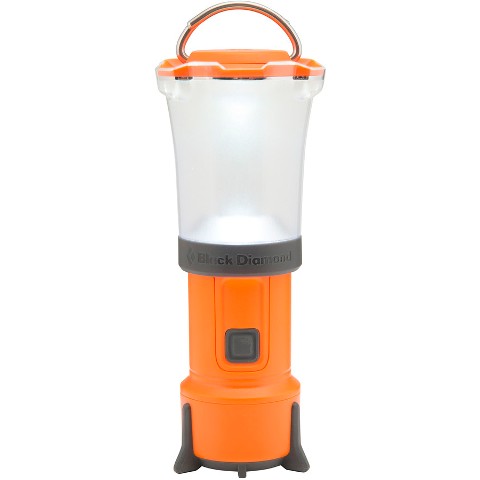
Orbit lantern with its globe deployed
Size and Weight
When fully deployed, it measures 5.5 inches tall and is just over 2 inches in diameter. The frosted plastic globe collapses downward over the base for transport and storage. In the stowed configuration the Orbit is a petite 4 inches.
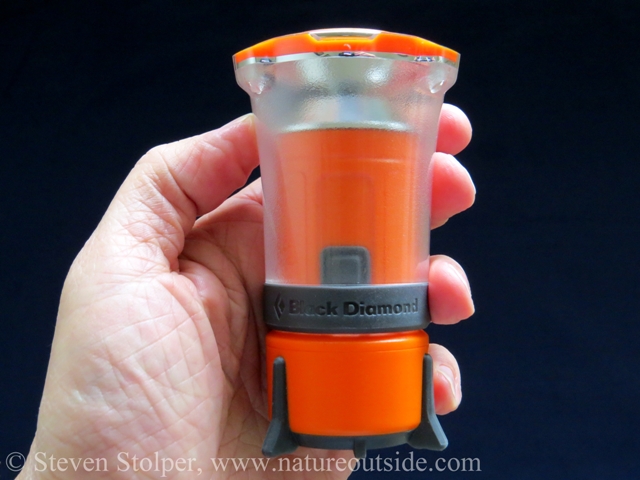
The Orbit lantern collapsed. (2014 model shown)
With four AAA batteries, the unit weighs just over 4.7 ounces (132 grams).
Operating Modes
The Orbit Lantern has three illumination modes: Lantern Mode, Flashlight Mode, and Dual Mode (both lights on).
Lantern Mode is the one I use most. The upper LED illuminates the large plastic globe to cast light 360 degrees. When I place it onto a picnic table, flat rock or fallen log, this is the mode I use.
I never use Flashlight Mode. I prefer to use my headlamp or hand-held flashlight to conserve the lantern’s batteries for use around camp. The lantern can double as a backup flashlight if you forget your primary one or it fails. But holding the lantern as a flashlight is not as comfortable as using a dedicated flashlight or headlamp.
Dual Mode was a pleasant surprise! When I purchased the product my initial reaction was to dismiss the LED on the bottom of the unit as superfluous. But it is wonderful when used inside a tent! Hanging a lantern from the top of your tent illuminates the inside. But the body of the unit casts a shadow on the floor. This makes it difficult to perform detailed tasks using only the light from the globe. In Dual Mode, the bottom LED provides task lighting. The extra light makes it easier to read and to perform tasks like removing contact lenses.
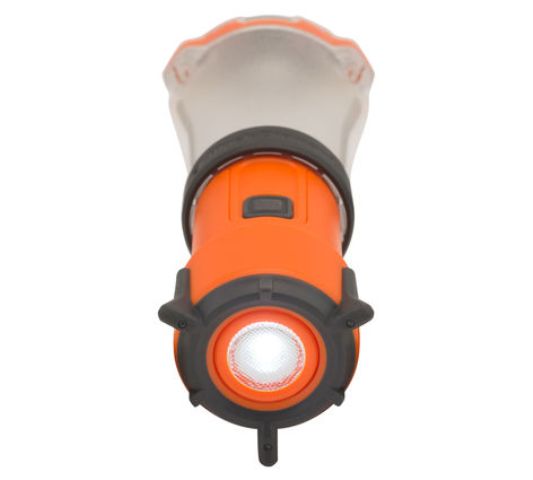
The Orbit lantern, bottom view.
In each mode, the lantern lets you select from several brightness levels.
Light and Run Time
Here is a table that shows the different lighting modes and characteristics. For comparison, a 60 watt incandescent light bulb produces 800 lumens.
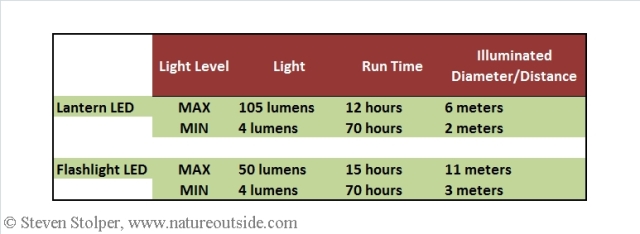
Orbit lantern illumination and run-time. (2015 model)
The run time seems reasonable. Lantern Mode at its highest setting runs for 12 hours. This equates to having it switched on for four hours each night (6:00 pm – 10:00 pm) over a three day trip. Using a dimmer setting extends that time considerably.
Colors
The lantern is made of plastic and comes in five colors. I purchased my “vibrant orange” lantern from an outdoor retail store. A salesman demonstrated the lamp to another customer while I shopped. It amused me when the customer left the store with a “matte black” unit. He thought it looked cool.
I don’t know about you, but I plan to operate my lantern at night, when it is dark. If I drop it on the ground while it is switched off I want to be able to find it again. So I recommend purchasing the orange, white or yellow units instead of the black one.
Operation
The lantern comes with a useful 1-page instruction sheet. But the font is tiny.
You insert the four AAA batteries by unscrewing the base of the lantern. The process is straightforward.
To extend the lantern globe, you pull it up while grasping the base. There is initial resistance and then the globe slides up and locks. Pushing on the globe collapses it back to the base for storage. The globe remains in place and I have not had to worry about it collapsing by accident.
I take extra care when I extend or collapse the globe. It requires some effort to overcome the initial resistance and I do not want to exert so much force that I break the globe or the base.
The lantern has a single rubberized button. Pressing it once illuminates the lantern LED (Lantern Mode). Pressing it a second time in succession turns off the lantern LED and lights the flashlight LED (Flashlight Mode). Three quick clicks lights both LEDs (Dual Mode).
But it is not so simple. The Orbit remembers the last mode in which you used it. So pressing the button once does not always give the same results. This behavior is nice if you cycle the light on and off frequently. It stays in the same mode. But it is confusing if you turn the light on after a longer period. The behavior is not consistent. So you don’t develop “muscle memory” for how many clicks put the lantern into each mode.
I avoid this problem because I primarily use it in Lantern Mode. So it is likely to enter this mode at startup. But I would like to see this behavior changed.
Once you are in the mode you desire, you can set the brightness level by pushing and holding the button. The light will dim steadily until it reaches its minimum output. It blinks once and then begins to increase until it reaches its maximum. Releasing the button at any point selects the current brightness level. The process is the same regardless of whether you are in Lantern, Flashlight, or Dual Mode. The orbit remembers your light level setting up to 10 minutes after you shut it off. So you don’t have to fiddle with the brightness every time you turn it on.
The top of the unit has two metal arcs that move independently. When you raise both they form a ring that you can use to carry or hang the lantern. I frequently raise only one of the arcs. This makes it easy to slip it through the nylon loops that hang from the roof of my tent. It also makes a convenient carry handle.
Test Results
I tested the Orbit at the Hodgdon Meadow campground in Yosemite National Park. I set up camp in the walk-in, tent-only, campground under a dense canopy of pine. Temperatures were warm and did not fall below the 40’s at night. The weather was fair so I did not test the lantern in precipitation.
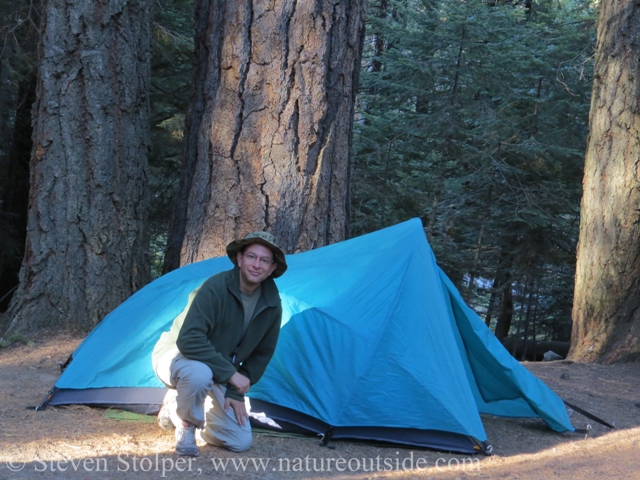
Camping at Hodgdon Meadow
I found the light level excellent. I was impressed that such a small unit could put out so much useful light. I wished for a red LED option to preserve my night vision. But I recognize that this feature is not widely desired by mainstream consumers.
An important point about using an LED lantern around camp is that it works best when hung above your head. When you place them on a table, for example, nearby objects cast very dark shadows. So you still need a headlamp to perform tasks like assembling your stove. But if you hang them from a tree branch overhead, they bathe the area with enough light to work without a headlamp. If there are no suitable trees nearby, one option is to carve a point on a downed tree branch and stick it in the ground as a stand to hang the lantern.
The Orbit is surprisingly stable on its six stubby legs (3 are tiny stubs). The plastic seems rugged enough to survive jostling inside my pack. It also looks like it would survive minor drops.
The Orbit is convenient to carry and hang. The controls are simple, except for the issue I described above.
Problems
I reviewed both the 2014 and 2015 models. The 2014 model has a clear globe and the newer 2015 model has a white translucent globe.
Although the 2014 model behaved well during my testing, it had a problem prior to the publication of this review. It started to fail intermittently. Investigation revealed that the AAA batteries were coming loose inside the battery case. Gentle jostling, or just extending the globe, caused the batteries to unseat. When it happened, the lantern failed to light. Avoid purchasing the 2014 model (clear globe), even at a steeply discounted price!
I purchased the newer 2015 model and re-ran my six-month test. The 2015 lantern has been updated with a milky white translucent globe and a “mask” around the globe’s base. More important, the lantern LED’s maximum output increased from 60 lumens to 105 lumens! Because of this change, I use the 2015 specifications in this review.
The 2015 model passed my tests with flying colors and continues to operate well.
Recommendation
The 2015 Model (white translucent globe) is Recommended!
It is easy to love the 2015 Orbit Lantern. I used it many times over a six-month period in a variety of conditions. It is compact and easy to carry. It provides great light and its two-piece hanging hooks make it easy to use inside a tent.
I suggest you remove the AAA batteries from the unit when you store it. This will help avoid the problem I saw with my 2014 unit where the springs became incapable of seating the batteries firmly against the contacts. This was not a problem with my 2015 unit. But I still recommend removing the batteries for storage.
I also advise care when extending the globe. If you pull with too much force, the globe can travel over its stops and pop off of the lantern’s base. This happened to me once and it was easy to reattach.
Price
The unit retails for $29.95 in the United States. But I have seen it advertised for as low as $22.00. Shop around to get the best price.
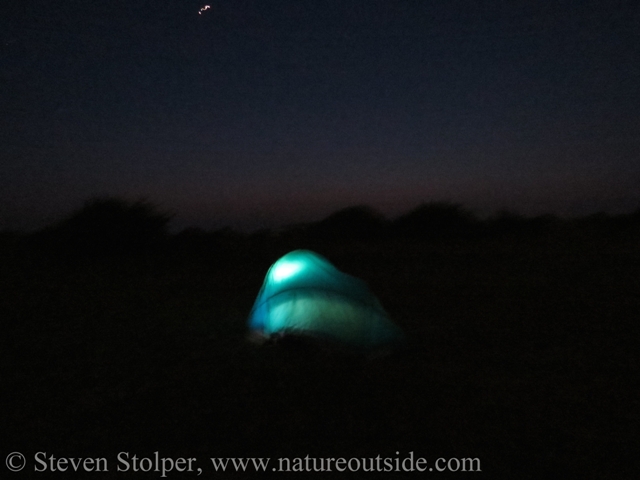
Two person tent illuminated by Orbit Lantern
Other Reviews on NatureOutside
Maxpedition Individual First Aid Pouch
10 Equipment Gifts for Bushcrafters, Nature Lovers, and People Who Love the Outdoors (2014)
If you enjoyed this post, you may like others in the Reviews Section.



Hi Steven
I recently bought an “old” black diamond Orbit that does not have the flashlight in the base. Only paid a few dollars for it at the Canton Tx flea market. Works great on eneloop NiMh batteries. Any idea how old it is?
Thanks
Tommy
Tommy, I don’t know for sure how old it is. The lantern first appeared on the market in 2009, winning a Backpacker Magazine’s Editor’s Choice award. At the time, it did not have the flashlight LED. I also found a 2012 YouTube review that appears to show an Orbit Lantern without a flashlight LED. But I was unable to determine when Black Diamond added it to the lantern (I did not contact the company). My guess is that, as of this writing, your lantern is between 3-6 years old.
If you only paid a few dollars for a working name-brand LED lantern in good condition, I’d say you got a good deal!
Hi Steve! This is an update on my “old” Black Diamond Orbit lantern. Have used my Orbit almost nightly for the last 3 years. It resides on my nightstand.
Still using Eneloop batteries. No problems!
If my Orbit fails on me tonight, I’m going tomorrow and buy the newest model.
I still love my hissing, spitting, smelly, finicky Coleman lanterns; just not on my nightstand!
Tommy
Glad to hear you like your Orbit, Tommy! I’m a convert to battery operated lanterns. They’re a lot easier to work with than the Colemans and I’ve stopped using them completely.